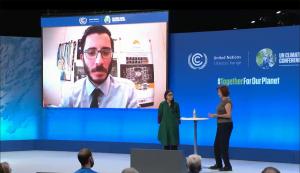ITER and the world fusion community on stage
The young children called back inside school by the bell on this crisp sunny morning must have no idea what is happening just a few hundred metres down the road. They are probably bewildered by the many police officers and black limousines in their neighbourhood, and by the crowds of people making their way to the gates of one of the world's largest and most important conferences—the 26th Conference of the Parties, COP26.
Whether nuclear technologies would be given a voice at this COP conference was unclear until a few weeks before the start of the event. But when the decision was made and publicized not only did the "Nuclear for Climate" initiative send a delegation of 50 young scientists to Glasgow, drawing attention with a flashmob in the city centre, but a delegation from ITER also head north.
On 4 November in the Action Hub, an amphitheatre set up in the centre of the conference venue, ITER presented the status of fusion research—both in the south of France, where ITER is being assembled, and worldwide. After an introduction by Matteo Barbarino from the International Atomic Energy Agency (IAEA) on the history of fusion research, seven projects were presented in short two-minute video clips including JT-60SA in Japan, the EAST tokamak in China, KSTAR in Korea, the Wendelstein 7-X stellarator in Germany, and the European JET in the United Kingdom.
The next stopover on this world tour was the American east coast where the fusion start-up Commonwealth Fusion Systems is collaborating with the Massachusetts Institute of Technology. The collaborative team reached a key technological milestone seven weeks ago in the demonstration of their high temperature superconducting magnet.
Last but not least, the floor was given to General Fusion, a privately financed project in Canada using a technology called magnetized target fusion. The company announced a few weeks ago that they plan to build a fusion demonstration plant in the United Kingdom.
Questions kept coming in from the audience and the more than 300 participants who had joined remotely to hear more about the technology of the future. "Count on us!" was the motto of the event. The full video of the Action Hub presentation can be found here.
Fusion energy and the ITER Project will again be on stage this coming Friday 12 November from 11:30 to 12:30 GMT. ITER Director-General Bernard Bigot and representatives from the United Kingdom Atomic Energy Authority (UKAEA), the University of Manchester, the Max Planck Institute, and the US NGO Energy for the Common Good will invite world leaders to look towards a future in which fusion is a key part of the world's zero carbon energy mix.
The panel session "Looking to the Future with Fusion Energy" will stream live on the UK Government's YouTube channel here.


